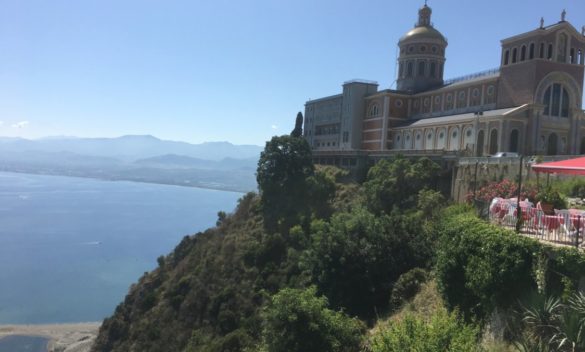Tindari, things to visit, the beaches and recommended hotels

Historical and archaeological heritage
Tindari, a part of the municipality of Patti, is a destination that attracts tourists with its rich historical, archaeological and landscape.
Address: Via Teatro Greco 36 98066 Tindari
Tindari
A village in the municipality of Patti, is a renowned tourist destination located in the province of Messina, famous not only for its rich historical and architectural heritage, but also for its natural beauty. Located on a promontory in the Nebrodi Mountains, Tindari enjoys a strategic position that frames the Gulf of Patti, with the Aeolian Islands to the north, the Milazzo peninsula to the east and the entire Peloritani chain to the south, offering visitors truly breathtaking views.
Its origins date back to very ancient times, as it is said that it was founded in 396 B.C. by Dionysius I of Syracuse and was named after Tyndaris, king of Sparta. This place, where history, myth, legends and archaeology are intertwined, was also a great source of inspiration for the writer Andrea Camilleri, who set an episode of Inspector Montalbano right here.
What to see in Tindari and around
In addition to being able to visit the Archaeological Area and the beautiful Basilica Santuario di Maria Santissima, Tindari offers places surrounded by greenery to discover. Visitors can take the time to visit the ancient center of this town, to make an excursion at the Coda di Volpe Path or carve out a few relaxing hours at the beach of Marinello.
Shrine of Tindari
The Basilica Santuario di Maria Santissima is one of the most important sacred places not only of Tindari but of all Sicily and is located in the easternmost part of the promontory where once stood the acropolis. The Sanctuary was built on the site of a previous religious building that was destroyed during the Ottoman invasion and rebuilt in the mid-sixteenth century. In 1953 it was necessary to enlarge and renovate the Sanctuary that led to the construction of the current building characterized by a Latin cross plan with three naves, square transept and semicircular apse.
Symbol of the Sanctuary is certainly the Black Madonna made of cedar wood with oriental features and dated between the eighth and ninth century. According to a legend, the ship carrying the statue took refuge in the bay of Tindari due to a strong storm but once back the serene this could not take off because of the heavy load. It seems, however, that after having deposited the statue of the Madonna the boat managed to resume navigation. The statue was immediately placed in the church that was at the highest point of the country and from that moment has become a destination for many pilgrimages. The Black Madonna of Tindari is represented with a crown on the head in the position of the “Queen on the throne” and holds in her arms the Child Jesus.
Archaeological Park of Tindari
The Archaeological Area develops between Tindari and the city of Patti and is of great historical importance since many finds have been found here that can now be admired at the Antiquarium Museum. The excavations made it possible to recover the Roman urban structure with the subdivision into thistles and decumans, several tabernae, important domus, villas and buildings such as the Gymnasium and the Theatre.
Studies carried out on the Theatre, in particular, revealed that this had already been built by the Greeks in the fourth century B.C. and was then rearranged by the Romans to make it an amphitheater suitable for the games of gladiators. Among the findings there were also remains of temples, such as those dedicated to Jupiter and Neptune.
Cathedral of Saint Bartholomew in Patti
The Cathedral of San Bartolomeo, commissioned by Ruggero d’Altavilla in the eleventh century, was built in the place of a fortress that had the role of a military stronghold. Several earthquakes have caused damage to the Cathedral which has undergone numerous changes and renovations over time. The religious building is now presented as a mix of styles that can be admired in the portal in Arab-Norman style, in the southern portico in Baroque style and in the different decorations made of lava stone and white marble.
Marinello Lakes Nature Reserve
The area of the Lakes of Marinello, better known as the Oriented Nature Reserve of the Lakes of Marinello, is located under the promontory that houses the Sanctuary of Tindari. This area, also called Dry Sea, is composed of sandy areas and water ponds that were born after the artificial interventions carried out downstream of the Timeto stream. The nature and conformation of these beautiful bodies of water make their number and shape vary according to the tides and seasons.
Coda di Volpe nature trail
The famous Coda di Volpe Trail also starts from the Riserva dei Laghetti, a route once used to connect the center of Tindari with the port of the ancient colony. The name of this itinerary derives from its particular shape that recalls the tail of a fox.
The itinerary that before was the pilgrimage route traveled to reach the Sanctuary of the Black Madonna is about 1.2 km long and crosses an area characterized by Mediterranean vegetation.
Its peculiarity, however, lies in the wonderful landscapes that range from the Lakes of Marinello to the Gulf of Patti to grant, sometimes, even a view of the Aeolian Islands.
- Historical and archaeological heritage
- Tindari
- What to see in Tindari and around
- Beaches around Tindari
- Where to stay in Tindari
- How to reach Tindari
- The Ancient Tindari -Tyndaris
- Where is Tindari located
Beaches around Tindari
In the charming natural setting at the foot of the historic center of Tindari is the Marinello Beach, located within the Marinello Lakes Reserve. This coastline, famous for its particular shape, is set between Milazzo and Capo d’Orlando and extends for about 2 km along the coast.
Surrounded by the beauty of unspoilt nature, the beach of Marinello is bathed by a crystal clear sea and is characterized by a soft and fine sand. This stretch of coast offers both an equipped area and a free zone. Near the beach there is also a cave, which according to a legend, was inhabited by a sorceress who attracted sailors with her song and then eat them.
About 5 km from Tindari, there is the small village of Mongiove, which houses a really beautiful sandy beach, with crystal clear sea waters that enclose caves and stacks not too far from the shore. Other nearby beaches include Marina di Patti, consisting of sand and gravel, Galice and Gioiosa Marea.
Where to stay in Tindari
In Tindari there are no hotels, so the best solution is to stay in neighboring places, such as Patti, Mongiove or Oliveri. In these cities there are different accommodation options, ranging from hotels to B&Bs, from accommodation in historic residences to holiday homes.
Check availability near TindariHow to reach Tindari
Tindari is easily accessible by car from the main towns of Sicily. From Messina, you can take the A20 motorway to the Falcone exit and from there take the SS 113 and then the SP107 to Tindari. From Palermo, however, you can always follow the A20 motorway to the Patti exit and then take State Road 113. The town can also be reached by car from Catania, either by taking the A20, or by taking the SS116 and the SP120.
Near Tindari there are the railway stations of Oliveri-Tindari and Patti, both located along the railway line Palermo – Messina. The nearest airports are Palermo Falcone-Borsellino Airport, about 200 km away, and Fontanarossa Airport, about 130 km away.
The Ancient Tindari -Tyndaris
Information about the ancient history of Tindari is scarce and fragmentary.
The Greek city “Tyndaris” was founded in 396 B.C. by Dionysius of Syracuse as a strategic point of his control over the Tyrrhenian coast.
In 344 BC, she joined the Corinthian Timoleontes in charge of restoring democracy in Syracuse, which had been troubled by serious internal political unrest and the Carthaginian threat.
It is believed that in the second half of the fourth century a federation of small Sicilian coastal towns opposite the Aeolian Islands was led by Tindari. This is demonstrated by the presence in the area of the founding hero of Achatyrnon.
Tyndarys is also mentioned in the time of Hieron II, during his campaigns against the Mamertines. In 270 BC, the ruler of Syracuse advanced on Alesia, Abakanion, and Tyndaris, encircling his enemies and defeating them later in the Battle of the Longan River, after securing Tauromenion and Ameselon.
During the First Punic War, the Carthaginians established a garrison at Tyndaris. Suspecting that the population was favorable to the Romans, they moved the most important citizens as hostages to Lilibeus. After the fall of Palermo in 254 BC, Tyndaris and other centers surrendered spontaneously to the Romans and became part of the Roman province of Sicily.
In 146 BC, the Tindaritans joined Scipio Aemilianus in the Third Punic War. During this time, Scipio returned to them the statue of Mercury, which had been stolen by the Carthaginians. After the end of the Punic Wars, Tyndaris was one of the 17 Sicilian cities allied with Rome, authorized to offer a crown to Venus Ericina.
Verre’s greed led to Tyndaris being plundered. Verre even took the statue of Mercury to his villa in Messina. The city played an important role in the denunciations against the violence perpetrated by the propretore.
In 40 BC, the city was captured by Sextus Pompeius and used by him in the fight against Octavian. However, Agrippa managed to conquer it. Augustus gave Tyndaris a boost in 22-21 BC, granting her colony status, recorded in inscriptions as “Colonia Augusta Tyndaritanorum”.
In the first century after Christ, Tyndaris seems to have been struck by a natural disaster that swallowed part of the city, according to Pliny even “dimidiam Tyndarica urbem”. This event may have occurred after the period of Stabo (66 B.C. – 24 A.D.).
From 535 to 836 AD, the city was under Byzantine rule and became a bishopric in the fifth century. The Arabs destroyed Tyndaris in the ninth century, and the history of the city and its diocese fell into obscurity.
Archaeological finds in Tyndaris are of great interest and offer a view of its ancient history. Many of them were discovered mainly in the 1950s and 1960s. Despite the lack of visible temples among the ruins of ancient Tyndaris, the coin issues reflect a varied and rich pantheon. The first four centuries of the history of Tyndaris are characterized by thirty-six series of coins, divided into three periods.
The impressive and important remains of ancient Tyndaris include the city’s wide perimeter walls, the Roman amphitheatre, the basilica, the baths, some houses and streets with significant mosaics. The museum houses valuable archaeological finds. Visitors moving beyond the Sanctuary will find the remains of ancient Tyndaris, discovered and preserved by the Superintendence of Antiquities.
Where is Tindari located
Located in the north of Sicily, Tindari is part of the municipality of Patti, 25 km from Milazzo, 59 km from Messina and 107 km from Cefalù.
ACCOMODATIONS NEAR TINDARI
Explore the best accommodation facilities near Tindari, between Hotels, B&B and Apartments, selected based on thousands of verified reviews.
Last updated on: 14/08/2023 12:07:31
checked by operator: Trude
 BUDGET ACCOMODATIONS
BUDGET ACCOMODATIONS HOTEL
HOTEL APARTAMENTS
APARTAMENTS HOTEL FOR FAMILIES
HOTEL FOR FAMILIES